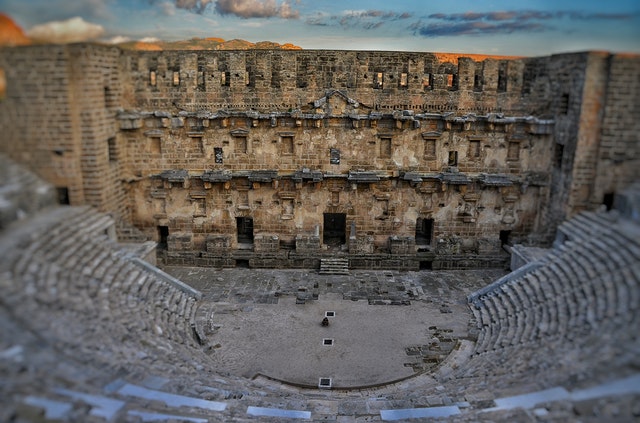The buildings used for theatrical performances in Britain were amphitheatres introduced by the Romans, who reproduced theatres from early Greece. All these were semi-circular constructions, constructed of timber originally and rock in later times. They had been open to the atmosphere with banked seats surrounding a raised point for example, Elizabethan and Jacobean theatres which were open to the elements. Although, the stages were covered and usually painted underneath with the sun, moon and stars to represent the heavens.
The medieval theatre style was introduced on grandiose temporary stages in fantastic halls, barns, or in the spacious courtyards of galleried inns. It was from those that Elizabethan timber-framed open-air theatres took their shape in London. They have been frequently multi-sided buildings,  using a coated platform stage against a single side. The crowd stood or sat in coated galleries across the adjacent sides or at the open courtyard. Each of the performances took place in daylight.
using a coated platform stage against a single side. The crowd stood or sat in coated galleries across the adjacent sides or at the open courtyard. Each of the performances took place in daylight.
Interest in theatre increased through the Stuart period in the seventeenth-century. Many wealthy courtiers and aristocrats hosted touring theatrical productions in their houses. Masques also were a favourite form of diversion for the royal court and the very wealthy, frequently commissioned for parties. They’d include dancing, music and elaborate costumes and scenery. The architect Inigo Jones invented the collections for many royal masques, and afterwards went on to style theatre buildings. He’d toured Italy and France and had been heavily affected by their layouts. He’s also credited with introducing the original proscenium arch — a decorative architectural framework above a thrust stage.
In eighteenth-century theatres, the interior design style is usually elegant and simple. Sometimes set artists and painters, proficient at producing illusion and unique effects, were utilised to decorate theatres.
Throughout the nineteenth century, architects started to work closely with interior designers to make opulent interiors. All these were often a blend of previous fashions. Exotic style components became trendy, particularly Indian, Arabic and Chinese styles. Some theatres replicated the buildings of ancient Rome, Greece or Egypt. Other designers were affected by the decoration of hippodromes or circuses, which were frequently adorned with animal themes.
At the end of the nineteenth century, electrical and gas lighting significantly influenced theatre interior decoration. Both managed to light up interiors better than candles or oil lamps and may be dimmed to darken the auditorium during the operation. Designers generated more striking, sculptural decoration with weathered and stained plaster using deeper shadows and much more pronounced surfaces. Gilded plasterwork also became popular, as did the use of mirrors and glass, including chandeliers, creating opulent auditoria and public spaces with posters hung on exhibition walls.
Theatre façades also became more opulent and imposing. They might be topped with pediments, balustrades, turrets and domes, or adorned with statues and sculptures upon museum plinths as well as columns and pilasters. They were adeptly lit to produce dramatic areas similar to those inside and suggesting an alluring indication of the splendour behind their doors. A magnificent façade was a method to attract viewers.
After World War One, theatre interiors started to be influenced by the United States of America, where lush new cinemas were being erected in the art deco style. This was symbolised through sturdy geometric shapes, flat shapes, streamlined frames and polished veneers and lighting effects.
The 1970s and 1980s saw the increase in popularity of black box theatres, with bare and blacked out interiors which allow for maximum flexibility of a facility to accommodate different types of performance.
A more recent trend in interior decorating is to create a theatre interior that celebrates and promotes distinctiveness. Some new facilities have large windowed atriums, easily visible from the street. These new artistic theatres urge people to enter, as they can easily see inside, inviting them to use their numerous services and welcoming them into the theatre world.
Secret Cinema is a style of theatre. Secret Cinema was founded in 2007 by Riggall, who founded Secret Cinema having been a movie aficionado since childhood.
At the beginning of Secret Cinema, information about the performances were kept secret and they were located in extremely strange sites. The initial performance, of the horror movie Nosferatu, occurred at an old nightclub underneath the railway arches of London Bridge.
At the moment, things are much more distinguished. The most recent performance, called Romeo + Juliet: Truce of Two Houses, was a live-action experience in the form of a festival, located in a west London park.
Secret Cinema has transformed the way we watch films into a social event, by engulfing viewers in the worlds of cult-classic movies like Blade Runner and Moulin Rouge.
For every event, crowds of up to 5,000 people per performance are welcomed into a decorated, immersive environment, complete with sets and actors of the screening movie.
